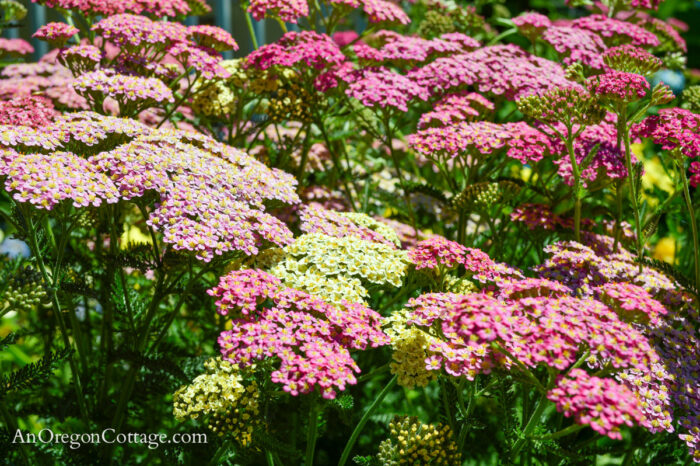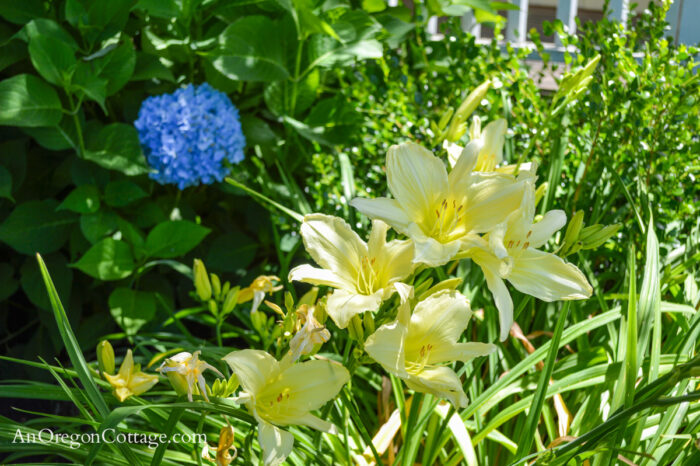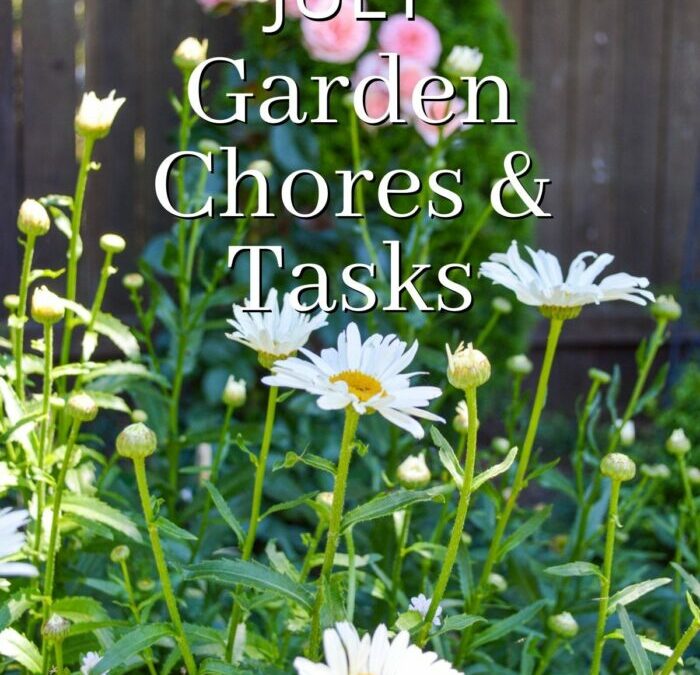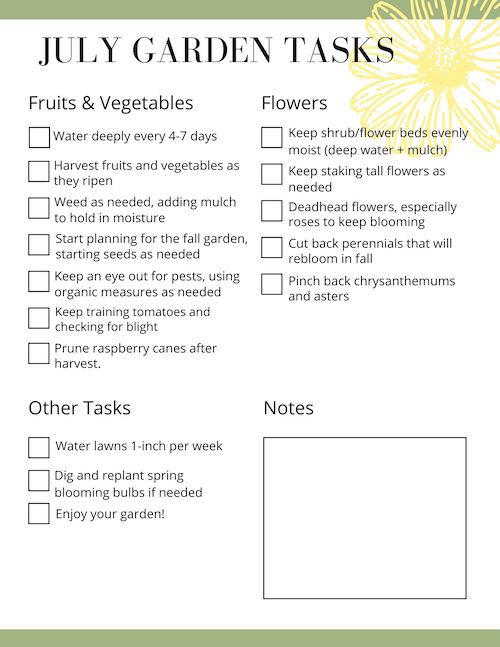A simple monthly checklist of July garden chores, including fruit and vegetable gardens, flower gardens, and basic lawn and yard care. Use this and the printable checklist an inspiration to remember what you can be done in your garden.

Here in the Pacific Northwest the month of July usually starts a dry weather cycle (that’s my hope at least, ha!), which makes the garden chores at this time mainly consisting of watering, watering, and more watering.
If you use a traditional vegetable gardening method (like tilling a large section of ground in the middle of grass), you will also be weeding, weeding, weeding, so that your growing vegetables can get all the water, sun, and nutrients they need.
Interested in weeding less?
I’m all about easy maintenance and weeding less! Check out these articles:
You can probably see that I don’t want to spend all my time weeding – and I don’t want you too, either!
Make it easy on yourself and grab all of my simple gardening tips and techniques in my ebook!
In addition to watering (and some weeding, a-hem), harvesting bouquets of flowers and baskets of vegetables should happily account for a lot of the garden’s chores (that is why we do this, right?).
Dealing with disease and bugs are the other things we need to be vigilant about.
Sometimes it seems never ending and I have had my moments of, “why am I doing this again?” when I see all my work go down the drain from blight, cucumber beetles, or voles.
Until I get a bite of that sun-warmed strawberry or flavorful tomato. Sigh.
That’s what we have to keep in the front of our minds!
PRO TIP: I’ve since tested this DIY garden insect spray and it really works (with pictures to prove it) for a lot of plants!
I’ve created a handy checklist of the tasks listed in this article!
Grab this free printable by clicking the image below to open in a new window and then download, print, and add any of your own specific chores to the notes section:
Don’t forget to add this page to your Gardening Notebook Journal!
Garden Chores for July

Vegetable & Fruit Garden
- Water regularly, preferably with low ground watering (soaker hoses or drip irrigation) that keeps leaves dry to discourage disease and keep weeds down from paths. Watering deeply once every 4-7 days (more in hot weather, less in cooler) encourages deep roots and healthy plants versus light waterings daily or every other day (deep watering = 2-4 hours with a soaker hose, or until the soil is moist an inch down). If you’d like to automate this on the cheap, check out how we installed a pvc watering system in our raised bed garden!
- Harvest and enjoy the fruits of your labor! Remember how long it takes to harvest and prep the food and pencil it in on your to-do list.
- Weed as needed and mulch with straw or grass clippings to help keep soil evenly moist.
- Plan for a fall garden: Plant beets and carrots by mid-July; plant transplants of cauliflower (fall and overwintering), broccoli, kale and cabbage (fall & overwintering); plant quick maturing bush beans; continue to plant a row of lettuce the first of each month.
- Monitor for pests: climbing cutworms (pick by hand or use Bt), tomato hornworms, cabbage loopers, cucumber beetles, flea beetles, etc., etc., etc. Sigh – just try to be on top of it, because they’re always there! This DIY Insect Spray is one easy thing that can help.
- Stake and train tomatoes as they grow, monitoring for blight. If you see it (yellowing leaves, black spots on stems & leaves), prune for air circulation at the bottom and centers of plants and cut off affected leaves. Treat with organic fungicide as last resort.
- Remove raspberry canes that have fruited after the June harvest (the browning and withering canes), leaving new, green canes. For everbearing canes, trim only the part of the can that bore (typically the top), leaving the remaining cane to bear in the fall.
Flowers

- Keep flower and shrub borders evenly moist (if you used the paper-and-mulch weed suppressing method, this will be a lot easier).
- Stake tall flowers as they bloom like delphinium and hollyhock.
- Deadhead (cut off old blooms) flowers as needed – preferably by cutting lots of bouquets to enjoy inside! PRO TIP: when you cut roses, trim them off just above a leaflet with five leaves.
- Coax fall blooms from the following perennials by cutting back after initial bloom: Shasta Daisies, Scabiosa (pincushion flower), Yarrow, Ladies’ Mantle, Coreopsis, Rudbeckia (black-eyed susan), Salvia/Sage, Veronica (speedwell)
- Pinch back Asters and Chrysanthemums once in early July to keep plants more compact and delay blooming, then deadhead to encourage consistent blooming.
Other Tasks

- Water lawns 1 inch per week (again, encourages deep root growth) – use a tuna can as a water measure to be sure how much the lawn is getting. Here’s more about watering in the summer.
- Dig and replant spring blooming bulbs now, if desired for thinning or new location.
You can see all the month-by-month garden chores lists here.
Need more easy gardening tips?


Original Article: Source



